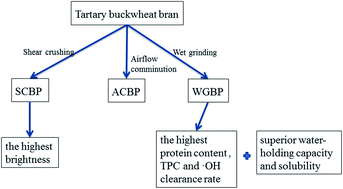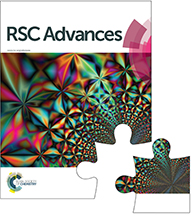Effect of different superfine grinding technologies on the physicochemical and antioxidant properties of tartary buckwheat bran powder
Abstract
The effect of shear crushing, airflow comminution, and wet grinding on the physical and chemical properties of Tartary buckwheat bran (TBB) powder was compared. Superfine grinding significantly reduces the particle size of bran (1.644 μm), while increasing the protein content (23.60%), water-holding capacity (4.38 g g−1), solubility (21.077 g 100 g−1), bulk density (0.34 g mL−1), and tap density (0.53 g mL−1) providing good processing characteristics. The antioxidant properties of bran powder prepared by the three methods mentioned above were compared. The results showed that different bran powders subjected to superfine grinding displayed varying levels of antioxidant capacity. The quercetin content (2.18 g 100 g−1) of the wet-grinding bran powder (WGBP) was twice that of the control group, while no rutin was detected. The total flavonoid content (TFC) and total phenolic content (TPC) were significantly different from those of other groups. The DPPH, ˙OH, and ABTS+ removal rates were 60.74%, 86.62%, and 92.98%, respectively, while that of ˙OH was significantly higher than in the other treatment groups. The control group, shear crushed, and airflow comminution bran exhibited no significant differences in TFC, TPC, and oxidation resistance, except for the ability to remove ˙OH. TBB powder obtained via superfine grinding displayed superior taste and functional characteristics, providing a theoretical reference for the processing of this bran.



 Please wait while we load your content...
Please wait while we load your content...